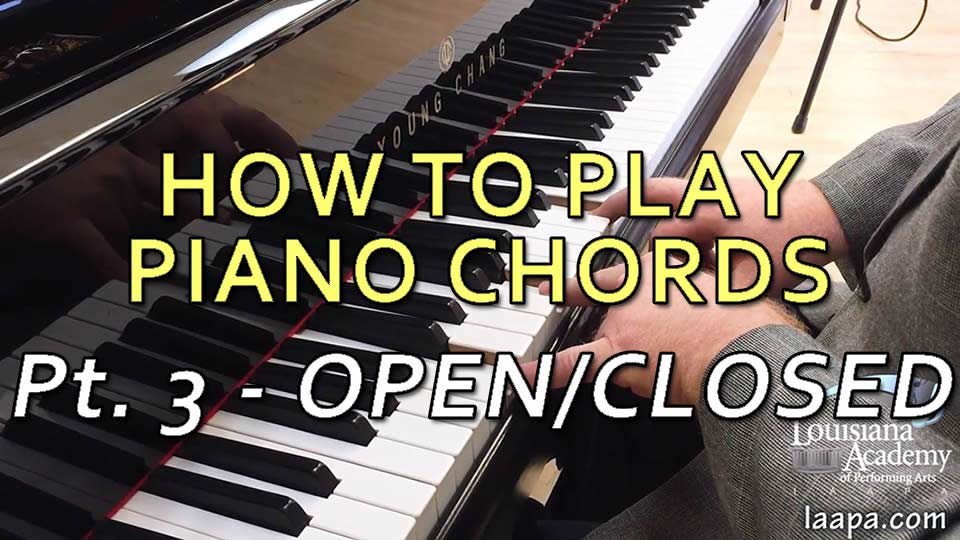How to Play Open & Closed Position Chords on the Piano
In part 3 of our three part major triad series, Ryan discusses how to get a big sound out of your piano triads!
Open and Closed Position Chords on the Piano
- contributed by Ryan Cullen
(00:15): Well, hello everyone, it's Ryan Cullen director here at the Louisiana Academy of Performing Arts. I'm here with you today to further discuss major triads. So, so far we've learned what a major triad is and we've also learned the inversions of a major triad. So what's next, you might ask, what else could we possibly know about a triad?
(00:38): Well, we can also talk about triads and positioning for the triads. There are two ways that you can play triads and their inversions. You can play them in what we call closed position, which is what we've been doing, where we don't leave any space in between any of the notes. They're all within one octave. Okay. But we can also do what's called open position where we spread out the notes a little bit more. So for example, if we have a C triad, we could play something like this. Taking the middle note of the chord and moving it up to the top of the voicing and this gives you a little bit bigger of a sound.
(01:38): You can do that of course, with any inversion. So what if I wanted to do a second inversion I could do something like that. I'll just go down the line here. So root position, then I could do first inversion, second inversion. So what's happening in each case is we're taking the middle note of the chord and we're moving it up to the top of the voicing. So I'll do it one more time. C and root position. We took the E here, and we moved it all the way up here.
(02:27): Now, first inversion, we would normally play this right E, G, C. Now we're taking the G and we're putting it up on the top voicing. Then finally, the second inversion we'd normally play like this. We're going to move it all the way up here. Generally speaking, when you're doing open position chords, of course you could do really open, which is going to be maybe. But when you have more than a sixth, an interval of a sixth, between your voicings or between your notes, I should say, you start to lose kind of the continuity of the chord. It doesn't sound quite as full when you have spacing of more than a sixth or seventh sometimes. So I recommend really sticking with this is the largest gap that you try and use.
(03:33): Now, can you add something below this? Sure. You could take your base note. Let's say C is down here. Then we could do an E up here. Then we could do maybe a C here. Then we could do a G over here. We have something like that. We could even put a fifth down here and that's a very nicely done full chord. If you notice, we have my rule that I just mentioned no more than a sixth in between anything. Now in the left hand, sometimes you can do just a root of the chord and a tenth or an octave, that's kind of common, but it's nice to throw down the fifth, if you can. There the fifth of the chord. Okay.
(04:33): When I'm saying the fifth or the third, just to reminder these numbers are coming from the scale degree of the triad. So when we say the fifth, that's a G because it's the fifth note of the C scale. So that kind of goes back to your scales. E would be the third where C is the root.
(04:58): So let's do one more. First, let's kind of open the chord. So let's do, I don't know, a D flat or C sharp major triad. All right. So first we're going to open it up. We're going to take the D flat. I'm more of a flat person. So if you're a sharp person, forgive me. But we'll take the F and put it up here. Okay. So normally D flat we'd have the F right down here. We're going to move it right up here now. There you go. You can do that.
(05:42): Those are all the various inversions. Now, what if I really wanted to give some power to that? I could do something like this. That's a very large chord. Could also do something like this, you could combine open and closed. So maybe I would do an open down here in my left hand and then put the closed on top. That's a pretty common thing that I'll use a lot. So left hand open, right hand closed. So what I'm doing in my left hand here on the C chord is I just played an open root position, C triad. Then in my right hand, I took a second inversion closed position triad in C. Together they make a really solid chord. I could even add a little G on top there, so four note triad, which I guess it's not really a triad anymore, but you get the idea.
(05:42): So that is open position and closed position chords in a nutshell there. So I hope you've enjoyed that tutorial. Go ahead, back over to the piano. Now, if you're not already there and see if you can pick out your open position chords and your close position chords, mix and match them and see what kind of chords you come up with. See you next time. Take care.
